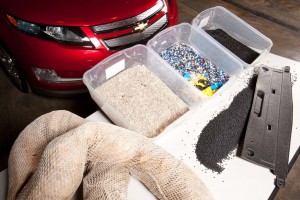General Motors’ efforts to burnish the Chevrolet Volt’s “clean and green” image have now extended into the oil-soaked waters of the Gulf of Mexico.
The maker has been able to recycle the polypropylene plastics used in the oil booms that were set out to contain and capture the oil spilled by a runaway British Petroleum well. In all, about 100 miles of booms were recovered and reused, according to Mike Robinson, GM vice president of Environment, Energy and Safety policy.
GM and its suppliers are turning the re-cycled material into plastic parts used in the Volt, such as a shroud for the radiator, Robinson said.
“Creative recycling is one extension of GM’s overall strategy to reduce its environmental impact,” Robinson said, noting that the maker already finds ways to eliminate landfilling at 76 of its facilities. The recycling of Gulf oil booms, he added, “is a good example of using this expertise and applying it to a greater magnitude.”
The oil-soaked booms pulled from the Gulf are put through a centrifuge process that removes the oil and water before they are shipped on to a GM supplier, which recycles the raw material, a plastic known as polypropylene, into plastic resin pellets.
Chris Miller vice president of sales and market for GDC Inc. of Goshen, Indiana, said material from the old booms is mixed with other recycled material, including used tires, to yield a plastic resin which can be shaped into a variety of plastic parts.
“The recycled resin is a lot less expensive than virgin resin,” he said.
In fact, GM’s Robinson described the overall process as “cost-neutral,” meaning the final parts and components cost it the same as those produced by more conventional processes.
Recycling the booms will result in the production of more than 100,000 pounds of plastic resin for the vehicle components,” said John Bradburn, manager of GM’s waste-reduction efforts, eliminating an equal amount of waste that would otherwise have been incinerated or sent to landfills.
“This was purely a matter of helping out,” said John Bradburn, manager of GM’s waste-reduction efforts.
“If sent to a landfill, these materials would have taken hundreds of years to begin to break down, and we didn’t want to see the spill further impact the environment. We knew we could identify a beneficial reuse of this material given our experience,” Bradburn added.
The project demonstrates the booms, which are also widely used around construction projects and limited spills, don’t have to buried or burned but can be recycled, said Bradburn, who noted it also should encourage the manufacturers of the booms to make them easier to recycle.
Besides GDC, GM worked with several partners throughout the recovery and development processes. Heritage Environmental managed the collection of boom material along the Louisiana coast.
Mobile Fluid Recovery stepped in next, using a massive high-speed drum that spun the booms until dry and eliminated all the absorbed oil and wastewater. Lucent Polymers used its process to then manipulate the material into the physical state necessary for plastic die-mold production.

